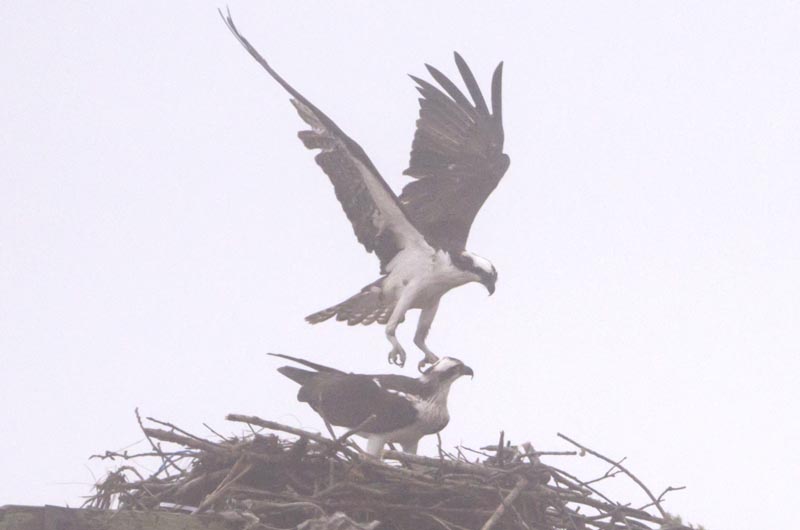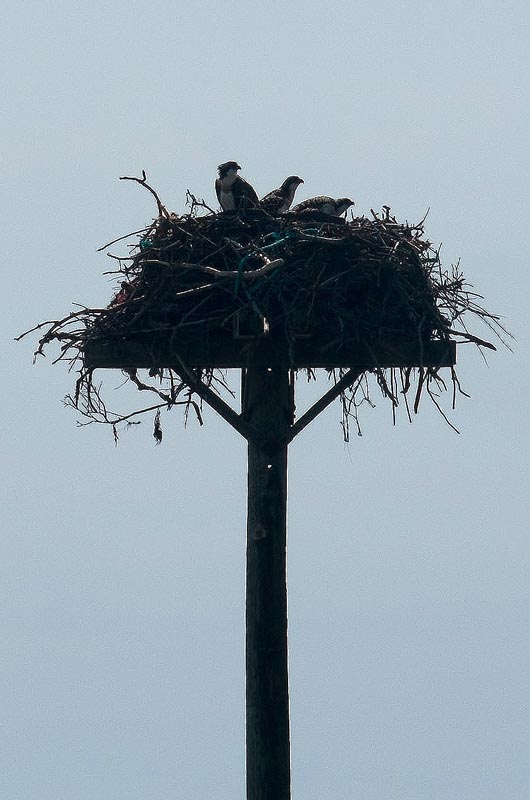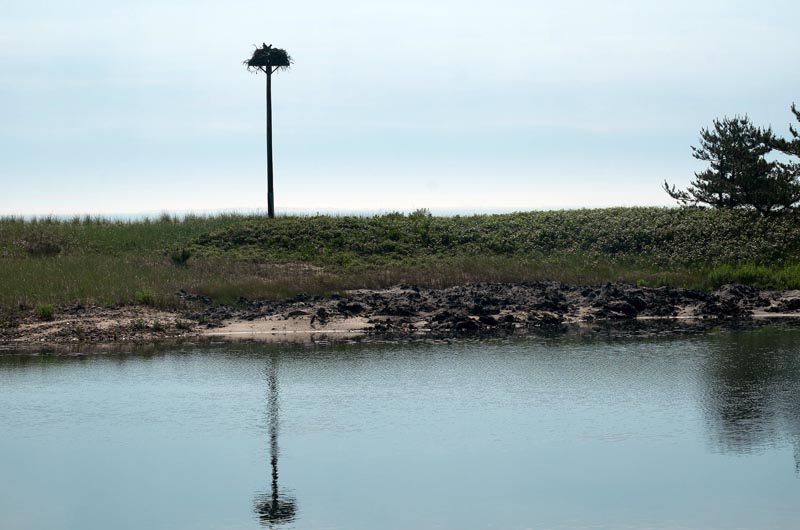It’s been a record-breaking year for Vineyard osprey, the majestic raptor that now nests on the Island in greater numbers than ever before.
Home to only two breeding pairs in 1970, the Island can now count 83 such pairs of osprey among its avian residents. Once forced off telephone poles and offered no alternative home, the ospreys have become highly prized Island birds and the tenants of human-made nesting platforms throughout the perimeter of the Island.
“It is really fascinating to see the numbers increase and to watch each pole annually to see how many we get,” said Susan Whiting, an Island ornithologist and natural history expert who writes a weekly column for the Gazette.
And in the broader context of species recovery, the Island’s flourishing osprey population puts it among the most productive sites in the region.
Nurtured, studied and counted since 1970, Island ospreys are featured in a forthcoming study which looks at the post-DDT recovery of osprey in southeastern New England and New York.
Here on the Vineyard, most breeding osprey pairs make their homes not in the tops of dead trees, but atop the pole platforms built just for them. Augustus Ben David 2nd, a noted natural history expert and passionate lover of all things feathered, began constructing artificial osprey platforms in 1971, when the tree hosting one of two active nests blew down in a storm. By 1991, Mr. Ben David and friends had put up 100 poles across the Vineyard.

To date, he has constructed the majority of the 139 platforms which stand on private and public lands across the Island.
Assuming a task involving physical strength, a solid understanding of physics and a strong relationship with the power company, Mr. Ben David has constructed osprey poles in each town, affording opportunities for survival for many pairs of birds. Over the years, osprey have made the sites their homes, raising young and returning to nest year after year.
Suffering a similar fate as the bald eagle, osprey across the region were once threatened by the widespread use of dichlorodiphenyltrichloroethane (DDT) in the 1950s and 1960s, an insecticide that caused the thinning of their eggshells. Towns on Martha’s Vineyard stopped applying the DDT in 1958; its use was banned elsewhere in 1972.
Though few in number, the two breeding pairs active on Martha’s Vineyard in the late 1960s were surprisingly productive. Still, a mystery persisted. As the years passed, why wasn’t the number of breeding pairs increasing? Mr. Ben David soon found the answer during a conversation with a utility worker, who told him that osprey nests were often removed from power lines to protect the power supply.
“They didn’t know there was an issue with osprey reproduction,” said Richard O. Bierregaard, Jr., ornithologist and co-author of the study. “They were just doing their job and didn’t know anyone was interested in ospreys.”
A partnership with the utility began, and to this day, when power line workers encounter a misplaced osprey nest, they call Mr. Ben David. If the area is suitable for osprey habitat, he builds an alternate pole.
Mr. Ben David continued to monitor the osprey for 20 years, and to count each bird during the summer months. For some time, he observed the osprey from a friend’s yellow Super Cub aircraft, which she flew low and slow enough to see the birds in their nest.
“Thanks to Gus’s stewardship, the osprey population on Martha’s Vineyard is one of the most significant colonies in southern New England,” Mr. Bierregaard said.
Help also came from individual donors and homeowners amenable to hosting osprey families on their private property. Mr. Bierregaard, a self-proclaimed “raptor nut” and a lifelong summer resident, took over the count in 1998, but Mr. Ben David continued to oversee the management of the poles.
These days, the census falls almost entirely to Dick Jennings, an Oak Bluffs resident, who works with David Kolb and other volunteers to visit each nesting site three times during the season. It’s a mad dash to get out to see each of the active nests, some of which are inconveniently placed at the farthest corners of the Island, including Chappaquiddick and Gay Head.
“Dave and Dick are stretched pretty thin,” Mr. Bierregaard said, adding that additional volunteers would be welcome. Mr. Jennings also works with Mr. Bierregaard to trap and tag osprey.
Three Vineyard ospreys are currently flying with small tracking devices, including Belle, Snowy and Mr. Jennings’s own namesake, DJ. He found DJ with his mate laying eggs in the dunes along the Poucha Pond marsh on Chappaquiddick. Four years later, DJ occupies a nesting pole nearby during the summer and flies to Venezuela in the winter.
Mr. Bierregaard began working on the osprey study 12 years ago with the goal of telling the whole story of the resurgence of the region’s osprey recovery. “It was sitting on Gus’s clipboard, and in state reports, but there wasn’t any one place where the story was told in scientific literature,” Mr. Bierregaard said.
Osprey are fish-eating birds of prey recognizable by the tips of their wings, which resemble the five fingers of the human hand. Osprey admirers say they are attracted to their aerodynamic form, the way they glide above the water, then smash into it to catch a fish in their talons, before carrying it back to the nest head-first, like a rocket.
“They are spectacular in their own way,” Mr. Bierregaard said. “Aerodynamically they have some incredible adaptations; they are such a highly specialized bird.”
Mr. Jennings, who spends many hours with osprey each week, points to their extensive migratory ability. “I think it’s nothing less than miraculous, how they can find their place whether it be in South America or the needle in the haystack home they have on Martha’s Vineyard,” he said. “It’s absolutely mind-boggling.”
For Ms. Whiting, it’s the independence of the male and female birds during their winter vacation, she said. “The women go one place and the men go another and then they come back and join hands,” she said. When she visits an osprey nest these days, she is looking for young osprey that may have hatched earlier in spring. “Basically, what you are looking for this time of year is heads of little ones sticking up,” she said.
Along with the 83 breeding pairs, Mr. Jennings has recorded 106 chicks Islandwide, including 12 sets of triplets. In 2008, there were 59 breeding pairs and 122 youngsters.
In August, Mr. Jennings will conduct a final census of the birds before they fly south.
This time, he is looking for the display of preliminary flying skills in youngsters, a behavior Mr. Jennings describes as “helicoptering out of the nest.” When the young birds fly, Mr. Jennings rests easy. “At that point, I can write them off,” he said. The female osprey leave the Island first, followed by the male and their youngsters, one-fifth of whom will not make it through winter. Each year, the adult ospreys migrate as many as 4,000 miles to South America to spend the winter.
Some nests also fail, and often for mysterious reasons. This year, there have been 11 nest failures, possibly due to storm events. Some platforms that housed breeding pairs for many successive years stand empty today, awaiting new tenants. Mr. Ben David does not dwell on these events, which sadden some of his friends.
“Only the superlative survive,” he said.











Comments (1)
Comments
Comment policy »